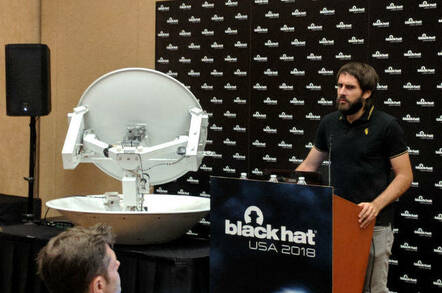Hackers can cook you alive using ‘microwave oven’ sat-comms – claim
Planes, ships, military equipment at risk due to backdoors, vulns

This. Is. Smarter! … Ruben Santamarta
Black Hat Four years ago, IOActive security researcher Ruben Santamarta came to Black Hat USA to warn about insecurities in aircraft satellite-communication (SATCOM) systems. Now he’s back with more doom and gloom.
During a presentation at this year’s hacking conference in Las Vegas this week, he claimed he has found a host of flaws in aircraft, shipping, and military satellite comms equipment.
These security shortcomings can, it is alleged, be exploited to snoop on transmissions, disrupt transportation, infiltrate computers on military bases, and more – including possibly physically directing antennas at nearby fleshy humans and using the high-frequency microwave-band electronics to bathe them in unwanted amounts of electromagnetic radiation.
“It’s pretty much the same principle as a microwave oven,” he told The Register. “The flaws allow us to ramp up the frequency.”
The vulnerabilities stem from a variety of blunders made by SATCOM hardware manufacturers. Some build backdoors into their products for remote maintenance, which can be found and exploited, while other equipment has been found to be misconfigured or using hardcoded credentials, opening them up to access by miscreants. These holes can be abused by a canny hacker to take control of an installation’s antenna, monitor the information the data streams contain, and in some cases change where it is pointing.
“Some of the largest airlines in the US and Europe had their entire fleets accessible from the internet, exposing hundreds of in-flight aircraft,” according to Santamarta. “Sensitive NATO military bases in conflict zones were discovered through vulnerable SATCOM infrastructure. Vessels around the world are at risk as attackers can use their own SATCOM antennas to expose the crew to radio-frequency radiation.”
Essentially, think of these vulnerable machines as internet-facing or network-connected computers, complete with exploitable remote-code-execution vulnerabilities. Once you’ve been able to get control of them – and there are hundreds exposed to the internet, apparently – you can disrupt or snoop on or meddle with their communications, possibly point antennas at people, and attack other devices on the same network.
This is all particularly worrying for military antennas. Very often these are linked to GPS units, and an intruder could use this data to divine the location of military units, as well as siphon off classified information from the field. Similar SATCOM systems are often used by journalists in trouble spots; unwelcome press interest could be targeted, perhaps terminally.
In satellite-communications units for the shipping industry, Santamarta said he found flaws that could be used to identify where a particular vessel was, and also damage installations by overdriving the hardware. Malicious firmware could be installed to interfere with positioning equipment, and lead ships astray, it was claimed.
Santamarta also postulated crews and passengers on container and cruise ships could be harmed by directing microwave-band antennas at them. There are safeguards to stop equipment from being pointed at people and effectively used as radio-frequency weapons, but those could be overridden, he claimed. The amount of harm caused, if any, of course, depends on the power of the system.
Mitigations
Some of these software flaws remain unpatched, as manufacturers continue to develop updates, while others privately disclosed to vendors have been fixed.
He also claimed it is possible to take over an aircraft’s satellite-communications system from the ground, depending on the model, and then potentially not only commandeer the in-flight Wi-Fi access point but also menace devices of individual passengers. The in-flight wireless network could also be hacked while onboard the airplane, we’re told, if you’d rather not go the SATCOM route.
It would not be possible for him to hijack the aircraft’s core control systems, though, as these are kept strictly separate and locked down. The aircraft SATCOM holes have since been fixed, he told the conference. ®
Sponsored: Following Bottomline’s journey to the Hybrid Cloud
READ MORE HERE

